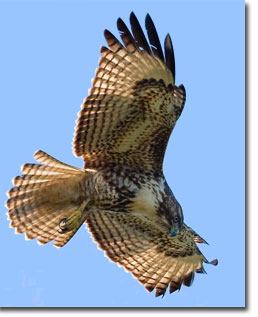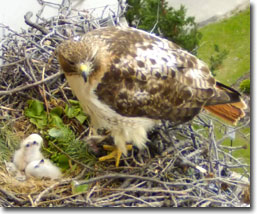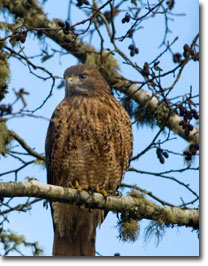Red-tailed Hawk
Buteo jamaicensis
Description & Range:
Red-tailed hawks are large, broad hawks with rounded wings and a short, wide tail. Most red-tailed hawks can be easily identified by their streaked belly bars. Their characteristic red-tail is cinnamon above and pale below. Red-tailed hawk bodies are typically dark brown above and pale below. Red-tailed hawks have two color morphs- a dark phase and a rufous phase. The dark phase birds have dark brown coloring all over while rufous phase birds have reddish brown coloring on the chest.
Red-tailed hawks are found throughout the much of the United States and Mexico year round. Their summer breeding grounds include the northern United States and Canada. The winter (non-breeding) range includes coastal portions of Central America.
Habitat:
Red-tailed hawks usually prefer open areas along scrublands, fields and farms. Often, red-tailed hawks can be seen perched on telephone poles, posts and/or trees along edge habitat.
Diet:
Most of the red-tailed hawk’s diet consists of small mammals including voles, moles, mice, rabbits and squirrels. Red-tailed hawks also catch and consume other birds such as northern bobwhite quail, European starlings and blackbirds.
Reproduction:
Before bre eding in March, Red-tailed hawks perform a quite dramatic courtship display. Ther display begins with both the male and female soaring in wide circles. The male takes a steep, downward dive and then rises up just as quickly. After a couple dives, the male and female will often touch and will sometimes lock talons, spiraling downward in the air until they release each other.
eding in March, Red-tailed hawks perform a quite dramatic courtship display. Ther display begins with both the male and female soaring in wide circles. The male takes a steep, downward dive and then rises up just as quickly. After a couple dives, the male and female will often touch and will sometimes lock talons, spiraling downward in the air until they release each other.
Following courtship and breeding, both the male and female red-tailed hawk will work together to build large nests out of sticks. The nests are typically 29-38 inches in diameter and up to 3 feet tall! Generally, construction takes 4-7 days. Clutches of 1-5 eggs are laid in March or April and that take around a month to incubate. During this time, the eggs are susceptible to predators such as owls, crows and raccoons. Often, the female tends to the young (also known as eyasses) while the male hunts and brings food to his family. After 42-46 days, the eyasses will fledge and will take up to 7 weeks to become independent of their parents. Red-tailed hawks become sexually mature around 3 years of age and can live up to 21 years.
Sounds:
Adult red-tailed hawks make a hoarse screaming “
kee-eeeeee-aar” sound which lasts 2-3 seconds and is usually given while soaring. Throughout courtship, they make a shrill “chwirk” sound, sometimes giving multiple calls in a row.
Behavior:
Red-tailed hawks are large birds with sharp talons and may be aggressive when defending their nest or territory. They will chase off other hawks, eagles, and owls. Birds in courtship fly with their legs hanging beneath them and will chase or swoop at each other, sometimes interlocking talons. Red-tailed hawks are mostly monogamous and will stay together until one of the mating pair dies.
Did You Know?
In many old western movies, the cry of the red-tailed hawk was played with the picture of soaring bald eagles. The oldest known red-tailed hawk was over 28 years!
Acknowledgements (photos - top to bottom):
- Red-tailed hawk in flight, USFWS
- Red-tailed Hawk with chicks, courtesy of University of Wisconsin, Madison
- Perched Red-tailed hawk, USFWS